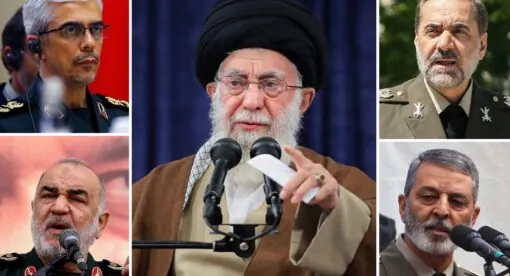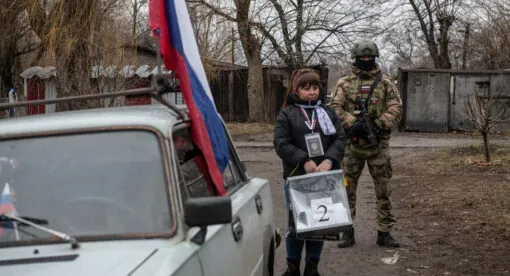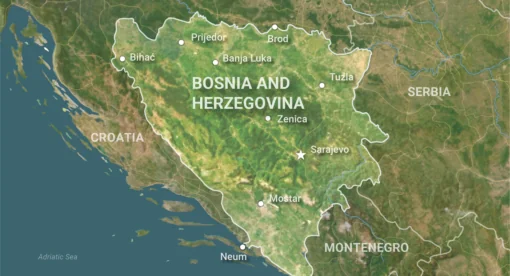In this segment of the Contours podcast series, Nicholas Heras is joined by two leading experts on the Indian Subcontinent and climate change – Dr. Syed Mohammad Ali and Dr. Saleem Ali – to discuss the geopolitics of climate change in India, Pakistan, and South Asia overall. The discussion then dives into the key findings from Dr. Saleem Ali’s forthcoming book, Earthly Order: How Natural Laws Define Human Life (Oxford University Press, 2022) on how the local, regional, and global effects of climate change are impacting human societies. They also highlight what policy actions the United States can take to help mitigate the prospect of climate-induced state collapse, conflict, and other trans-national threats to human security on the Indian Subcontinent.
Nicholas Heras: Hello, everyone. Welcome to this edition of Newlines Institute for Strategy and Policies’ Contours podcast series. My name is Nick Heras, and I’ll be leading today’s timely discussion on the effects of climate change on human security on the Indian subcontinent. I’m joined today by two leading experts on the Indian subcontinent in climate change, Dr. Syed Mohammad Ali, and Dr. Saleem Ali.
Dr. Syed Mohammad Ali is a non-resident scholar at the Middle East Institute, and he teaches at Georgetown and Johns Hopkins Universities. He frequently provides expert testimony for South Asian asylum seekers to immigration courts in the United States and United Kingdom. He also works with several think tanks in Washington, DC, and he writes a weekly column for Express Tribune in Pakistan.
Dr. Saleem Ali is the Blue and Gold Distinguished Professor of Energy and the Environment at the University of Delaware. His research focuses on causes and consequences of environmental conflicts, how ecological factors can promote peace, and on environmental conflicts and extractive industries, especially minerals. Saleem is also the author of a new book: Earthly Order: How Natural Laws Define Human Life, which will be released by the Oxford University Press this summer. In the book, he connects genres of natural science leadership with social science and politics through systems analysis. He weaves personal narratives of field experience as a National Geographic Explorer who has visited 150 plus countries and witnessed firsthand environmental challenges to in turn provide an eclectic, culturally nuanced interpretation of system science and its application to achieving sustainable development. He has also pledged that all royalties from the book will be donated to environmental literacy programs.
Mohammad Ali and Saleem, thank you for joining us for today’s timely, important discussion. Thank you both for joining us today. Mohammad Ali, I’d like to start off by asking you the first question. As you both know, most of the attention on the South Asian region is focused on the protracted rivalry between India and Pakistan, the nuclearization of the Indian subcontinent, the unfolding great power competition in the region, and the fear of regional destabilization due to the withdrawal of US military forces from Afghanistan. Yet several South Asian states are facing major climate change risks, which have the potential to exacerbate existing security challenges facing the broader region, as well as to impact the human security of this center of human civilization.
So Mohammed Ali, I’d like to ask you, can you explain why climate change undermines security and what is the value of thinking of climate change from a human security lens?
Syed Mohammad Ali: Absolutely. Nick, if we think about climate and climate threats as an issue, they certainly have a human security implication. Human security is when you are, rather than thinking about conventional ways of contending with insecurity and relying on military might, the idea of a humancentric notion of security is that you are looking at how these insecurities impinge on the lives of people and trying to think of securitizing people from the bottom up, if you will. Having this humancentric approach to the notion of security rather than putting nations to the forefront. Climate is an issue which is now compelling the world at large and neighboring countries and nation-states themselves. Ideally, they should be rethinking issues like security. In the context of South Asia, for instance, it’s often been mentioned that there are these protracted rivalries in the region, and the threat of terrorism and all these issues pale in comparison to the multifaceted challenges posed by climate change.
MA: If we look at the region, the larger region, I mean, even the smallest states like the Maldives are facing oblivion with rising sea waters. But other states like Bangladesh, very populous states like Bangladesh, and of course India and Pakistan, the latter to have been in the topmost list of hotspots, if you will, global hotspots, which are facing, even as we speak … Both these countries are, have seen unprecedented heat waves in March and April. There’s a serious fear that we might have a drought on our hands within the region. Some of these states — like India for instance, is now an emerging global power, and just by virtue of the sheer size of its population, and India is a major emitter.
Now Pakistan and Bangladesh have a lighter ecological footprint, but it’s not because they have a more conscientious approach towards environmental issues. It’s more due to the relative sizes of their economies. But also other countries, I mean now there’s a lot of literature which also pulls in Afghanistan into the South Asia region. If you look at Afghanistan, Afghanistan keeps suffering recurrent bouts of drought, which are being exacerbated now by climate change. A country like Afghanistan, which is a landlocked country, has no water-sharing arrangement with any of its neighboring states. Despite the billions of dollars spent in Afghanistan on development issues over the past two decades, when NATO forces were there, this is not an issue that really came to the fore. They had some formal arrangement with Iran, which was formulated in the late ’70s, and then the Soviets came in and was never really operationalized. With Pakistan, it’s upper and lower riparian at the same time, and it has no water-sharing agreement. So besides the Durand line, the political border, water can also become a source of contestation between Afghanistan and Pakistan.
Of course, between India and Pakistan, this remains a major issue and something that we will talk about more. This is perhaps why a few years ago, here in the U.S., The Department of Defense, of all entities, labeled climate change to be a threat multiplier, by which they meant that climate, because of its impact on water availability and the pressures that it applies on natural resources, is going to exacerbate existing tensions within countries and across them. In the case of the Indian subcontinent, here let’s think also of the Great Game, which is unfolding in the region. A lot of the water for the region comes from Tibet and the glacial melt. These are then waterways, if we are thinking of the Brahmaputra or we’re thinking of the Indus, they are shared by neighboring states which are not on the best of terms.
Here we can think back just a few years ago to how climate can trigge r… We had, I think Kofi Annan had said several years ago that the wars of the future are going to be fought over things like water. But also domestically, if we now think of Syria, of course there were multiple factors to the upheaval that we have seen afflict Syria over the past many years, but some of that, was also triggered, besides the Arab Spring, was triggered by years of drought, worsened by policies of international financial institutions like the IMF, which were compelling the Bashar al-Assad regime and not to be doling out public schemes and provide relief to the people because of the need for fiscal austerity, and that catalyzed migration into Damascus of this frustrated youth and the anger, it became an explosive situation. These are cautionary tales, now, for places like South Asia.
Lastly, the value of thinking of sort of climate change from a human security lens, we have to realize that even if there is that shift, that shift in itself does not only mean emphasizing climate change, but it means a greater reflection, a greater scrutiny of really thinking of how it is impacting people and which people are being impacted, because we can also have disparities and inequities when we are dealing with the environment. We have to bear in mind the issue of environmental justice.
A lot of the global attention right now is on averting future emissions, which is a ahistorical way of thinking about climate change. These are debates which are being had between so-called developing and developed countries, where a lot of the mess that we find ourselves in is not the doing of poorer countries, which are also energy-poor. In order for them to leapfrog, they are not getting the kind of financial assistance that is required. The emphasis on averting emissions of course is important, but there needs to be simultaneous attention paid to what is already happening to people, and particularly ironically, it’s the poorer people in the Global South which are bearing the brunt of climate change. That manifests itself, for instance, in the form of water scarcity.
SMA: It was at COP26 that we saw more attention being paid to issues like climate scarcity, which still deserves much more attention. There’s a lot of work to be done in terms of thinking of other realities that people are already facing on the ground, like migration. There’s a call for creating a new category of asylum seeking to recognize climate-based migrations. And of course, even domestically, a lot of work needs to be done to manage this process, rather than have unsustainable urban growth in poorer countries, which is going to add to the sprawling slums in poorer countries. All of these issues are also very relevant for South Asia, with its immense populations.Thank you very much, Mohammad Ali, for that detailed discussion on how climate change impacts our global order. In particular, I appreciate how you’ve woven into this discussion the idea that, in fact, climate change doesn’t impact everyone equally, and that the most vulnerable people across societies in many world regions are the ones who will feel climate change most intensely.
NH: I think this is a good opportunity for us now to pivot to Saleem. Saleem, you have many decades thinking about how climate change and natural science impacts human society. Your latest book, Earthly Order, tries to connect natural science to social and political science around environmental management, which is an exceptional effort. So Saleem, could you suggest to us how such an approach could be operationalized in South Asia to address climate change, especially with all the horrific stories we are seeing about how climate change is now impacting millions and potentially billions of people in that region?
Dr. Saleem Ali: Yes. Thank you, Nick. I have always felt that at the grassroots level in South Asia, there is a deep connection to nature, because much of the population has in fact made their livelihoods through the land. Pakistan and India have both been largely agrarian countries, and certainly even the other South Asian countries have had very strong roots in livelihoods linked to nature. In that context, it’s I think important for the educational system to catch up with what has been happening in people’s daily lives in any case, and make those connections between natural systems and how social and political systems then get organized.
Pakistan, for example, was one of the first countries to support large-scale membership in the IUCN. Within South Asia, it had one of the largest offices for it. IUCN is the International Union for Conservation of Nature. The World Wildlife Fund has had very strong representation from South Asia. So there has been this grassroots connection to the environment. In addition, industry in South Asia, and particularly in India and Pakistan, has had very strong connections to environmental systems. For example, Tata, which is a major business powerhouse in India, has been the leader in establishing sustainability education. They started TERI, which is the Tata Energy Research Institute that later became a graduate school as well.
In Pakistan, we’ve had one of the leading industrialists of the country, Syed Babar Ali, who was the global head of the World Wildlife Fund. He was also instrumental in establishing several environmental organizations. So I think Pakistan and India, and certainly in Bangladesh, also, with the establishment of several major NGOs like BRAC, there is a lot of potential to now make these connections, between grassroots activism around nature, and the environment and public policy. I would say that currently what people are feeling with the impacts of climate change is going to galvanize that kind of momentum at the grassroots.
The key question will be whether the political elite are able to capture this moment in a constructive way to also make policy changes. We have just seen one of the worst heat waves in South Asia in the last month. The World Meteorological Organization and some of the risk analysis researchers have just published a report, which has suggested that in the month of April as well as in early May, the heat wave that has been felt in South Asia is 30 times worse than what would’ve happened without climate change. The research is particularly compelling in that regard. By 30 times worse, I mean in terms of the likelihood of it happening is 30 times worse than what would’ve happened without climate change. So, the data is now pretty clear.
Now, that does not mean that we just give up and start to focus on a strategy of nihilism, which also happens with many such cases, where people just say, “Well, there’s nothing we can do about it.” I think that what we have seen with that grassroots movement and all of the positive changes there, are indicative that there’s a lot which can be done. So in my book, Earthly Order, I’ve tried to make the argument that we need to move away from environmental awareness to environmental literacy, and that’s needed across the board, whether it is at the educational level or it’s at the policy making level. We have currently a minister of climate change, for example, in Pakistan, who has noted the importance of climate change. She has in fact served as the Pakistani ambassador to the U.S. As well in the past, Sherry Rehman, and she could have had other portfolios in the Cabinet, but she chose climate change because of the salience that she feels it has across a lot of issues for the country.
In India, also, as well as in some of the other South Asian countries, we are seeing much more willingness to engage on climate change. There are countervailing forces, especially from the coal industry, in India as well as in Pakistan, which have been pushing back in terms of the green energy transition. That will need to be negotiated with livelihood concerns. But I think overall the momentum is there for us to really make that connection between the grassroots and the political establishment on climate change.
NH: Thank you very much, Saleem, for that detailed explanation on how environmental science and political science can work holistically together to improve the situation that we are now facing as a result of climate change in South Asia. I want to ask both of you now this question, and I know it’s complicated because of the nature of geopolitics and local politics within these two countries, but I’d like to focus on the two largest countries in the region, which are of course India and Pakistan. There are two parts to this question, which I think will need to be addressed. The first is how can Pakistan and India best adapt to climate change? And the second part of the question, which is of course the action piece of it: Who are the key stakeholders who can help both countries achieve these goals?
MA: Okay. Thank you, Nick. Going back to the 1960s, we have had major international development agencies and financial agencies in particular, like The World Bank, has been very proactive in trying to not only individually lend support. In the past, a lot of the development work was not ecologically beneficial, but they did at least try and contend with and very successfully tried and contend with the water-sharing dispute between India and Pakistan. These were countries that had already gone to war, and there were subsequent wars. But the Indus Basin treaty that The World Bank helped broker in 1960 has withstood the war in 1965, the war in 1971, and subsequent serious skirmishes between the two countries. However, this treaty took a very simplistic approach to water sharing, and it just divided the rivers coming out of the Indus and gave three rivers to Pakistan and the rest to India. Pakistan actually gets, because India has other sources like the Brahmaputra also coming into India, but for Pakistan, the rivers emerging from the Indus Basin are vital for agriculture because Pakistan uses well over 90% of the fresh water in agriculture. It’s not used very efficiently.
But when we come back to the Indus Waters Treaty now, and the Himalayan glacial melt, which is a looming threat as the world keeps heating up, already these are countries, like Pakistan is a water stressed country. If the source of that water is now threatened, we will start seeing more pressure being exerted on the Indus Basin treaty. There are calls to try and climate-proof that treaty, or perhaps even replace it with a more comprehensive treaty, which views and manages the Indus Basin in a more holistic manner. But the challenge is that, can something like this be done given the current animosity between these two countries?
Because of this animosity we already see on both sides, unfortunately, the weaponization of even environmental issues, which is obviously very detrimental. The impacts of climate change and lack of seriousness to the environment has evident impacts. So for instance, the U.S. National Academy of Sciences recently published research by academics which were looking at pharmaceutical contamination of rivers, and they found the River Ravi in Pakistan be the most polluted river in the world. Besides the industrial and other pollutants, which are recklessly discharged into the river, there’s also a drain which comes from India and flows into Pakistan, which is also a major source of pollution, posing then subsequent environmental and health risk.
Now both Lahore and New Delhi, which are about a half hour flight from each other, have been trading places as the most polluted cities in the world. Both of them blame each other for this air pollution. There’s crop burning, which adds, besides vehicular emissions and industrial emissions, cause this new season to have come to the fore, the fifth season: smog. During the winter months, there’s this haze, very toxic air. Both these countries blame each other for [inaudible 00:22:53]. In Pakistan, often it’s like, “Oh, India!” There’s Diwali in India now where there’s a lot fireworks, and you see the spike in air pollution, and crop burning on both sides.
But there this air pollution issue is not being effectively tracked. There’s no sign of cooperation between the two countries to try and think of managing it effectively. Of course, we know that the air does not respect political boundaries, no matter how militarized they are. India is of course trying to do things on its own, but in the case of Pakistan, some of the stuff that I’ve been tracking, the former government had embarked on this very ambitious tree tsunami, so the plantation of billions of trees to act as carbon sinks. Then they’d also launched another project called Recharge Pakistan. When the idea was that groundwater, which has been depleted with reckless abandon for agricultural use, and that water not being used very efficiently, there is need to try and recharge the aquifers. There hasn’t been that much progress on that particular project.
While these are good solid ideas, but then there are also counterproductive forces at work. So for instance, the coal-heavy energy projects that have been implemented under CPEC, the China Pakistan Economic Corridor. Recently, China has been talking about greening the Belt and Road Initiative, but for Pakistan, it’s also the economic pressure. Pakistan has a large reservoir of indigenous coal, which is not of good quality, but it remains adamant to use that rather than pay for expensive imports of oil, given the state of the economy. So there is that economic compulsion, but then there are also vested interests within the country, which had been pushing for these grandiose but environmentally very damaging projects, like the Ravi riverfront project, which has gone into litigation. But the idea was to try and sort of create these high-end shopping malls and plazas right on the Ravi River.
This recurrent emphasis on damming. While dams are ecologically less damaging to produce energy, but they have over time when you are playing with, and Saleem can perhaps speak more to these issues, when you are diverting water that is supposed to be going into the sea, you do see sea water intrusion. Already in coastal areas of the country, we’ve seen damaging of the mangroves alongside deforestation, which has been causing salinity in water in coastal areas, and causing all sorts of complications like mother and child mortality rates, because of salinity and high blood pressure.
I, for one, and perhaps this is me as a development anthropologist, have lesser faith in the ability of corporate social responsibility to try and contend with these issues, especially given its bottom line to maximize profit. There are these sophisticated articulations within the corporate sector on how managing the environment is also good for profit making. But if history is a guide thus far, over the past several decades and even some of the manners in which we see green energy is being pursued, the quest for green energy, it is not entirely proper.
Think for instance, slightly outside the region, but think of the sort of compounding the miseries of the poor miners in the DRC, who are extracting lithium, which is a wider component for the green energies. Think of the food price hikes when we saw the use of food crops for conversion into biofuels. And in the case of countries in South Asia, think to how companies like Nestle or Pepsi, which, they are major entrants into this bottled water. I remember for instance, 20, 25 years ago, we used to drink water out of the tap. Now, anyone middle class and above, anyone who can afford it, gets these containers on a weekly basis coming to the house, where you are being supplied bottled water at home for drinking purposes. But while you have these companies, which are presenting themselves as providing, addressing health concerns, but when you are bottling water, which takes how many liters it takes to produce one bottle of bottled water, which costs an arm and a leg, if you are a poor household. Obviously poor households cannot afford the luxury of buying water.
What that does, in turn, these are companies that are willing to make a profit and want to make a profit. They see a lucrative market and the sales are skyrocketing. However, the problem is, it’s a double whammy, because when you have the private sector providing alternatives to those who can pay, it kind of relieves pressure off the more influential people within these poorer countries who have the capacity to exert pressure on public utilities. Their children are not getting diarrhea because of drinking contaminated water, or water that has high arsenic content. They are not applying that kind of pressure, and these are the voices that the government will hear. As a result, there is lack of investment in public utilities. There’s regular mixing of sewage and drinking water. There’s a dearth, not only in rural areas, but also in urban areas. There’s water theft. There’s wastage, pilferage, and you have people standing in lines hours upon hours, women and girls in particular. I mean, it’s added to the burden of their household responsibilities of getting enough water to get by on.
I’ve given you like the glass half empty version. Maybe Saleem can speak to, perhaps, some of the solutions to some of these issues.
SA: I think that in terms of the India-Pakistan dynamic and environmental peacebuilding, so as to say, this is an emerging field actually within academic research, also — how environmental issues might be used to build trust between countries that otherwise might not have trust because of other factors such as ethno-religious conflicts, which is partly the case with India and Pakistan. There is potential. There are institutions even which exist. For example, even before the SAARC organization was formed, which is the South Asian Association for Regional Cooperation, there was another organization called the South Asia Cooperative Environment Program, SACEP. SACEP actually predates SARC and is headquartered in Colombo, Sri Lanka, and has all the South Asian countries as members, including India and Pakistan. SACEP had been given the mandate to foster environmental cooperation in the region and to depoliticize the environment from other kinds of disputes that may exist on the subcontinent.
I feel that such organizations need to be revitalized. I do feel there is external pressure needed on both India and Pakistan to utilize such organizations for finding some synergies in terms of environmental action projects, whether it is energy, technology exchange — India has been leading the way in solar power, for example. There could be a lot of positive investment regionally from some of those solar companies to help upscale solar power delivery. There could also be even a revitalization of some kind of a regional energy grid, if there could be further trust built. There was a program that USAID had many years ago called SARE/EI, which was to focus on South Asian regional energy exchange and integration where it made sense. We do have other regional energy programs that have been discussed with Central Asia. There’s no reason why there shouldn’t be also within South Asia.
I think that the environment does provide an opportunity. We are seeing that even in the case of the United States and China just in the last two, three days, in fact, in Davos at the summer Davos meeting. The UN had facilitated a dialogue, as well as the World Economic Forum, between various countries that were interested in climate change cooperation and the United States Special Envoy for climate change, John Kerry, actually met with his Chinese counterparts in Davos, and they issued an update statement, which noted that since the Glasgow Climate Change COP meeting last year, there has been progress on U.S.-China climate change cooperation, even though right now, we are probably at a time of the lowest kind of relationship and trust between the U.S. And China in the last 40 years. We are seeing that there is a willingness now to engage on climate change, despite all the other trust deficit issues.
I would hope that Pakistan and India can also learn similarly from the U.S. And China. I would say the U.S. And China should, as part of their climate change cooperation, help to pressure also India and Pakistan to have greater engagement, because China has a lot of leverage with Pakistan through the CPEC program, and the United States has a lot of leverage with India.
So there could be this much greater global good, which could come out from such interactions as well. That also resonates with my notion of earthly order, which I noted in the book — that rather than talking about world order and focusing on these kinds of very stylized institutions like the Quad or AUKUS and so on, if we really think in terms of earthly order, which is looking at planetary constraints to what we can do with politics, then we will see a much more integrated systems outcome for efficiency in terms of material usage, energy usage. That can actually help economically some of these countries as well, and also create a different way of looking at the future of global governance.
NH: Thank you both, Mohammad Ali and Saleem, for your responses to those questions. It’s very interesting how you both outlined some pathways that India and Pakistan and international organizations, as well as the Great Powers, can interact with each other to try to tackle this issue of existential importance to the human species.
I want to build on the points that you make by asking both of you another two-part question. Really looking at sort of the state of the environment in South Asia, and then to build on that, how the United States, in particular now the Biden administration, which has put so much focus on climate change and trying to tackle climate change through U.S. Leadership on the international level, can address these issues. We’re seeing them play out now live before our very eyes.
So the first part of this question, and I’ll start with you, Saleem, and then we’ll go to Mohammad Ali, is, can environmental issues potentially be used for peace-building in South Asia, and specifically on the Indian subcontinents? Then the second part is what are some of the opportunities for the international community, especially the United States government and the current Biden administration, to facilitate this process of peace-building by tackling environmental issues?
SA: I think that the United States currently has had a very detached interaction with Pakistan as compared with India. There is clear asymmetry in terms of the level of communication, and because of the United States coupling Pakistan’s relationship with that of Afghanistan and the U.S withdrawal. First of all, the U.S. will need to remedy this perception in Pakistan that it is a highly transactional, narrow relationship, because currently that has led to a level of distrust that will also then carry over into any conversations around climate change. I think that’s the first point.
SA: On the Indian side, I think the relationship is very strong with the U.S., both economically and at multiple levels. The Indian diaspora has had a very strong role in the U.S. also in terms of cultivating that relationship. I think there is much more leverage the U.S. has with India than it does with Pakistan. As noted earlier, I feel China has more leverage with Pakistan. So I think there needs to be, if there was a kind of a Quad around climate change, perhaps it would be the U.S., China, India, and Pakistan, working together on climate change in a more constructive way around finding synergies that can help in terms of technology transfer, which would allow for investment opportunities as well. So there can be a lot of win-win opportunities there for all these countries and leveraging, where possible, the ways in which we have seen other parts of the world develop adaptation infrastructure also.
We will need to move towards adaptation very soon, because there is a recognition that just reducing emissions is not going to be able to keep up with the changing climate at the level that is needed. So what we then need to do is think about adaptation mechanisms. I think the adaptation narrative has a lot of opportunities for leveraging cooperation between India and Pakistan as well, because the same cyclones or floods which are going to impact one country are going to impact the other. They are not going to look at political borders. So having early warning systems, which can help both countries adapt, develop those kinds of mechanisms whereby there can be technology transfer for adaptation, those can be really useful opportunities also for environmental peace-building between these countries.
MA: I was just thinking, Saleem has actually done very interesting work on having this kind of environmental diplomacy approach to managing even lingering territorial disputes between India and Pakistan. I think his earlier work on this revolved around Sir Creek, which is this estuary, and often fishermen from both sides are arrested and then detained, and then as a sign of good will, released after having spent some time in prisons across the border because they drift unwittingly into enemy territory. Saleem, I think, proposed this idea that there are, like the Ramsar Convention, for instance. It requires India and Pakistan to cooperate on these kinds of issues, and not only Sir Creek, but a similar approach, data sharing, and a more holistic approach to managing the Indus Basin would also do wonders for confidence-building between these two countries.
Because certainly in the absence to do so, we have political, opportunistic leaders who will talk in very adversarial terms. India has repeatedly threatened cutting off the water supplies to Pakistan with statements like “blood and water can not flow together.” On the other hand, in Pakistan, there have also been proscribed outfits like the Lashkar-e-Taiba calling India a water terrorist. When it comes to the Kashmir issue, of course, it’s a very complex issue. It also merits attention in terms of the political disgruntlement and the repression being suffered by Kashmiris. However, a lot of the sort of concern in Kashmir is that that is also the territories through which the waters of the Indus flow into Pakistan. Because these two countries share borders, as those waters are threatened over time, it is vital that they have a more cooperative approach.
The U.S. government has this track record of walking with these countries, and through The World Bank, having created this mechanism that now certainly merits revision, given the emergent sort of ecological environmental challenges. However, I would still caution that the U.S. government itself with its obsession almost with the market mechanism, and that’s an obsession that also carries over into The World Bank, and this idea of technological innovation being able to solve major problems, needs to realize that is not always the case. Sometimes technological, top-driven, market-driven, profit-driven strategies can often exacerbate problems, already severe problems like elite capture.
In the past, we’ve seen when policies like the Green Revolution, which was framed as the solution to addressing the food scarcity of growing global population, and this is, that Green Revolution was taken up in India and Pakistan and other parts of the world, but that Green Revolution did not only by its over reliance on chemical agriculture, fertilizers, pesticides did not create only a range of ecological problems like fertilizer runoff, first into the rivers and then into the oceans, and sort of the land degradation and land exhaustion by monocropping patterns trying to maximize profits, but it also benefited progressive, richer, and mid-sized farmers. In fact, that capital-intensive way of doing farming created deep peasantization.
In that same way, now the fear is that sort of this reliance on technologically driven efficiencies and corporate farming, for instance, could again have this labor-displacing impact in countries like India, like Pakistan. Already in India, we have seen its embrace of GMOs, BT cotton in particular. While it has enabled India to amplify its cotton exports, but at the same time, it has seriously exacerbated the indebtedness of poorer farmers who, given the fluctuations in weather, have faced crop failure, and they have borrowed money on high interest rates and are in desperation. We’ve seen thousands of poor farmers year upon year in India committing suicide. Recently, the Indian government had to sort of roll back its plans to further liberalize agriculture, particularly due to the high-handed manner in which those reforms were being implemented.
But I mean, there is need for balance in addressing these problems, because at the end of the day, there is this need to cater to the food insecurity and to adapt simultaneously to the climate, and a shortsighted ad-hoc decision like Sri Lanka implementing suddenly, primarily to save money because of its financial crunch, it just said, “We are not going to import any agricultural imports like fertilizer and pesticides, and we are going to go the organic farming route,” which caused devastation within Sri Lanka and has exacerbated hunger. So there is need to think of these issues in a balanced manner, in a scientific manner, with the cautionary note that technological innovation and profit-driven mechanisms can sometimes worsen the situation of the already marginalized.
At that broader level, I also found this idea of an environmental court interesting, because now China, in the same way that it has been trying to portray — while there’s been some disappointment around it — but it had framed its cooperation with Pakistan vis a vis CPEC, the China Pakistan Economic Corridor, as being a flagship project of the much larger, more ambitious Belt and Road Initiative. In the same way it can try and green the CPEC project, and that can be a flagship for further greening of the BRI Initiative.
The U.S. certainly in the long term can try and not only work individually with both these countries — and certainly it is showing much more willingness and resolve to work with India to address its environmental issues — but it should simultaneously be addressing these environmental challenges, which are transborder, because it has this lingering concern of the nuclearized Indian subcontinent. On the one hand, it’s still trying to bolster India’s capacity to stand up to China, but it wants to do so in a way that it doesn’t further exacerbate the acrimony between India and Pakistan. So one way of lessening that acrimony in the future would certainly be to try and help these two countries deal with their common environmental challenges.
NH: Thank you both very much for the detailed response. I would like to wrap up our discussion by asking Saleem: If you had the opportunity to put your new book, Earthly Order, on the desk of President Biden and his national security team, what would be the key point that you would hope that President Biden and his team take away from your book?
SA: Well, first of all, the point that I would make is that all social and political decisions are ultimately going to be dependent on natural systems. So when you set out certain green energy targets, for example, you say by 2030 we are going to try and transition to this kind of new technology, you will be constrained by natural systems in terms of how that performance can be delivered. For example, whether you’re choosing a metal in a battery that has to be sourced from China, or from some other part of the world, you are constrained by the laws of nature in terms of how you can deliver that outcome. All those decisions around policy targets need to be made through science-based decision making. That’s the first argument I would make to them. It can’t just be that you have some science advisor on the side who is giving you some occasional material and you try to incorporate that, but rather that you predicate your decisions on the constraints that are offered to you by natural systems.
Secondly, I would urge the administration to consider how … political borders need to be considered in terms of environmental and resource opportunities. For example, if you have rivers that are crossing international borders, you have certain parts of the world which have greater comparative advantage in providing natural resources. You need to find governance systems, hybrid governance systems, which can respond to those. You can’t just delineate political borders with a certain predetermined notion of this is the way we want countries to be, or this is the way we want borders to be. You need to consider those kinds of issues of porosity, where resources are flowing, where natural resources have advantage in certain areas in terms of the fertility of the land, in terms of where mineral deposits are. So you need to develop your governance systems around how you negotiate borders, especially political borders, trade borders, around those kinds of constraints.
So, those would be the two major take-home lessons that I would put forward. That would mean you think about creative means of how you would have these arrangements. You would need to think through, do we actually want to have some kind of a hard border in certain cases, but have a much more porous border in other cases in terms of resource flows? How do we navigate trade regimes around those kinds of constraints? That should be the priority, rather than just having this much more rigid notion of political borders that continues to be the mainstay in high politics.
NH: Thank you very much, Saleem, for that policy guidance. Hopefully, your book will make it on the desk of the president and his national security team. I want to thank you and Mohammad Ali for an excellent, in-depth, and nuanced discussion on environmental security and how it impacts the broader human security of South Asia, the Indian subcontinent, and the international connection in the shared species-level challenge. We here at the Newlines Institute for Strategy and Policy will continue to build on our research and analysis on the impact of climate change and environmental science on policy, both in the United States and globally. Thank you both. Thank you to all our listeners, and all the best.
Although transcription is largely accurate, there could be some inaccuracies due to inaudible passages or transcription errors.








